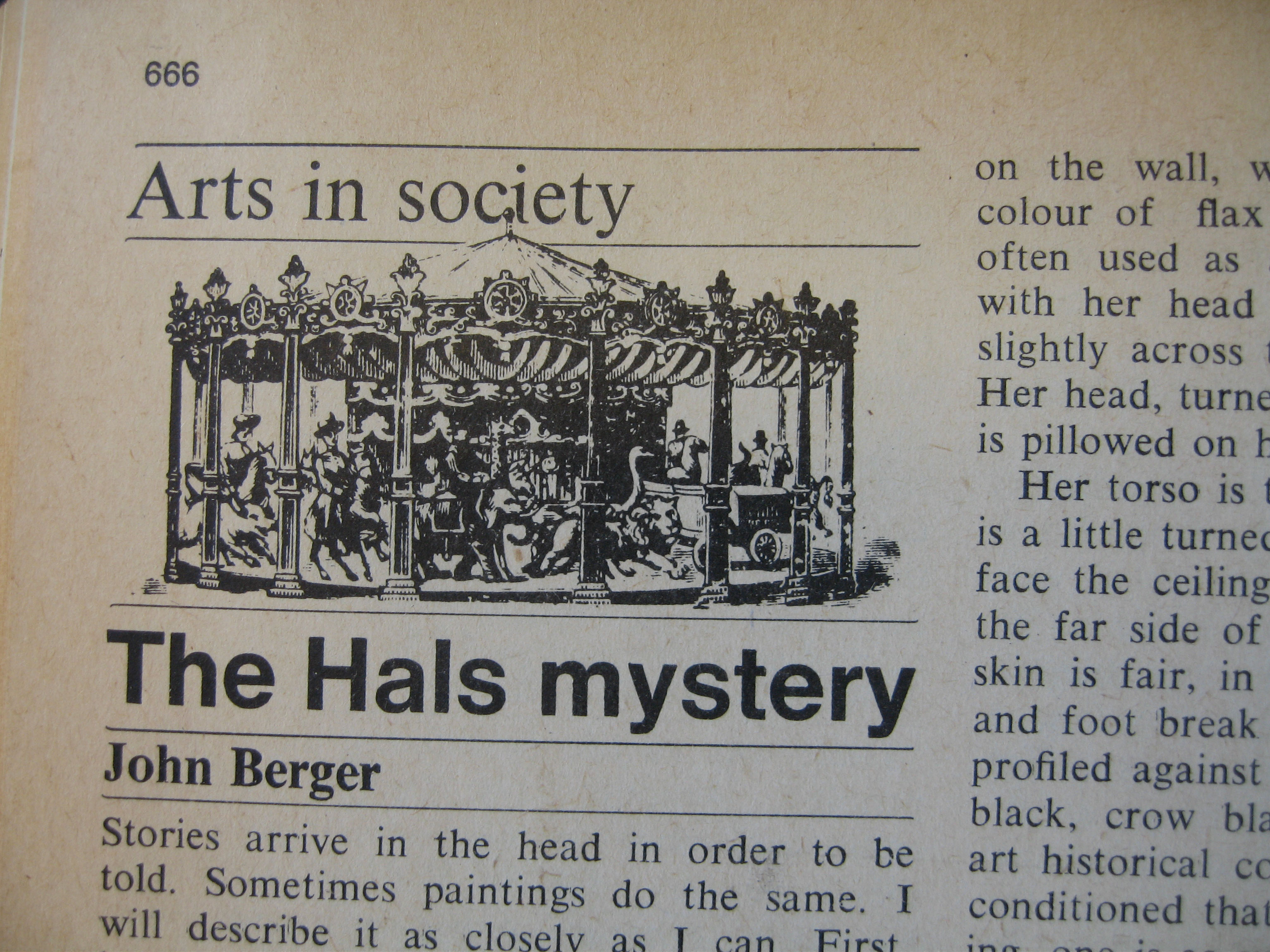The conditions of contemporary publication on the web that I’ve touched on in my two previous posts, “Invisibility and Criticality in the Imperium of Analytics” (July 31, 2011) and “The Imperium of Analytics” (August 2, 2011), made me interested in researching the conditions of the writing and publication of two essays I particularly admire yet whose publication has always seemed in some sense mysterious to me. These are two essays by John Berger that are among my favorites, both of which are included in Berger’s 1985 book of collected essays, The Sense of Sight: “The Moment of Cubism,” originally published in The New Left Review in 1967 and then in the 1969 book of the same name, and “The Hals Mystery,” originally published in the British journal New Society in December 1979.
The Sense of Sight is a wonderful book of writings about art and, at the same time, or at least when I first read it in the 1980s, it seemed like a rather strange book in comparison to other art history and theory books of the period. There are writings of every kind in it, including poems–the first piece in the book is the brief 1985 poem, “Rembrandt: Self-Portrait.” And it contains essays that seem so personal that you wonder what they are doing there, if, as I was, you brought certain expectations, of “objectivity” or academic impersonality, to essays about art, which is certainly the main subject of all the writings collected in the book.
I’m thinking for example of “Ernst Fischer: a philosopher and death,” a deeply affecting, incredibly tender account of the last hours in the life of Berger’s friend and mentor, the Marxist poet, critic, and politician Ernst Fischer (author of The Necessity of Art: A Marxist Approach). But nothing ever seems self-indulgent about these texts; each component of the book seems precisely chosen for its relevance to the underlying themes of the book. Re-reading the Fischer essay just now I think, here is a text not only about someone Berger loved, but also about his own writings, beliefs, politics. However the didactic, or polemic, or ideological, however you want to term it, is nestled in something intimate and elegiac. The relation of revolutionary hope, located in a near past in terms of the time frame of the essay written after Fischer’s death in 1972 (the Czech Prague Spring of 1968 had been crushed in August 1968), lost opportunities, and possibility of some redemption echoes themes of other essays, including “The Moment of Cubism.”
“The Moment of Cubism” is a thrilling essay because it instantly opens up a double vista to the past and to the future of an instance of radicality, whose promise is not completely fulfilled but yet may be ahead of us. Nostalgia, regret, wonder, and hope erupt out of the first sentence of the essay.
I find it hard to believe that the most extreme Cubist works were painted over fifty years ago. It is true that I would not expect them to have been painted today. They are both too optimistic and too revolutionary for that. Perhaps in a way I am surprised that they have been painted at all. It would seem more likely that they were yet to be painted.
Do I make things unnecessarily complicated? […]
And anyway is it not nonsense to think of Cubism as having not yet taken place when we are surrounded in daily life by the apparent effects of Cubism? All modern design, architecture and town-planning seems inconceivable without the initial example of Cubism.
Nevertheless I must insist on the sensation that I have in front of the works themselves: the sensation that the works and I, as I look at them, are caught, pinned down, in an enclave of time, waiting to be released and to continue a journey that began in 1907.
It is as if Berger adds an extra time warp to the trajectory of perception of Walter Benjamin’s Angel of History whose face
is turned toward the past. Where we perceive a chain of events, he sees one single catastrophe which keeps piling wreckage upon wreckage and hurls it in front of his feet. The angel would like to stay, awaken the dead, and make whole what has been smashed. But a storm is blowing from Paradise; it has got caught in his wings with such violence that the angel can no longer close them. The storm irresistibly propels him into the future to which his back is turned, while the pile of debris before him grows skyward. This storm is what we call progress. (excerpt from Benjamin’s ninth thesis in the essay “Theses on the Philosophy of History”)
Berger’s Angel of History sees over the pile of wreckage created by the catastrophic loss of faith that followed the First World War, back to the moment of Cubism’s unfinished revolutionary promise, its moment of man’s oneness with the world, and ahead to a future potential for completing Cubism’s vision.
It is hard to believe that Berger’s essay “The Moment of Cubism” was written over 40 years ago, and now sits in the middle of the 100 years that separate us from the moment of Cubism.
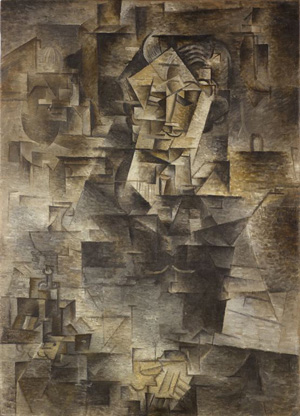
Pablo Picasso, Portrait of Daniel-Henry Kahnweiler, 1910, oil on canvas, 39 13/16″x28 7/8″, collection of the Art Institute of Chicago

George Braque. Man With Guitar, 1911-1912, oil on canvas, Collection of the Museum of Modern Art
Two of the epigraphs that precede the essay seem to point to the role of genius: Guillaume Apollinaire‘s poem stanza, “Certains hommes sont des collines/Qui s’élèvent entre les hommes/Et voient au loin tout l’avenir/Mieux que s’il était le présent/Plus net que s’il était passé” (from “Les Collines,” in Apollinaire’s Calligrames: poems of peace and war, 1913-1916, “Some men are hills/Rising higher than other men/The distant future they see/Better than if it were the present/More clearly than if it was past”) and George Braque‘s statement, “The things that Picasso and I said to one another during those years will never be said again, and even if they were, no one would understand them any more. It was like being roped together on a mountain.” However Berger quickly undercuts this notion:
Cubism cannot be explained in terms of the genius of its exponents. And this is emphasized by the fact that most of them became less profound artists when they ceased to be Cubists. Even Braque and Picasso never surpassed the works of their Cubist period: and a great deal of their later work was inferior.
As in all Berger writings, social and historical context is always central.
The developments which converged at the beginning of the twentieth century in Europe changed the meaning of both time and space. All, in different ways, some inhuman and others full of promise, offered a liberation from the immediate, from the rigid distinction between absence and presence….There was a startling extension through time and space of human power and knowledge. For the first time the world, as a totality, ceased to be an abstraction and became realizable. […]
Today we know that the world should be unified, just as we know that all men should have equal rights. Insofar as a man denies this or acquiesces in its denial, he denies the unity of his own self. Hence the profound psychological sickness of the imperialist counties, hence the corruption implicit in so much of their learning–when knowledge is used to deny knowledge.
At the moment of Cubism, no denials were necessary. It was a moment of prophecy, but prophecy as the basis of a transformation that had actually begun.
Because this moment of transformation was general, Berger notes that the Cubist painters and poets “did not think in political terms. Yet they were concerned with a revolutionary transformation of the world. How was this possible?…It was not then essential for a man’s intellectual integrity to make a political choice. Many developments, as they converged to undergo an equivalent qualitative change, appeared to promises a transformed world. The promise was an overall one.” But after World War I, men found themselves in the “negative possibility implicit in the new relation of the self to the world…the world, which was nevertheless indivisibly part of them, reverted in their minds to being the old world which was separate from them and opposed them…”
I could go on. I’ve left out Berger’s brief but eloquent and informative history of painting since the Renaissance, and his analysis of how the Cubist world view is embodied in its formal approaches–OK, just one quote from this section:
Rather than ask of a Cubist picture: Is is true? or: Is it sincere? one should ask: Does it continue?
My notes are filled with quotes and each sentence unpacks like a Zip file, information and directions for thought bursting from the miniature to the huge, but I’m mindful of the impatience of the web reader and of copyright infringement, so I hope you will read the essay, not just for the pleasure of reading Berger’s narration of the history of modernity and for his grounding of these broader themes within formal specificities of Cubist artworks, but for the distinction between the promise of the moment of Cubism and the distance we may feel from it now.
The Cubists “did not imagine and did not foresee the extent, depth and duration of the suffering which would be involved in the political struggle to realize what had so clearly become possible and what has since become imperative. The Cubists imagined the world transformed, but not the process of transformation.”
So how do we proceed now when the overall promise is more of a threat: world-wide corporate domination, limited resources, climate change? Can a moment when thinking politically must be a conscious choice move towards any kind of transformative revolution?
Berger ends with a reflection about the miracle of a beginning: “The moment at which a piece of music begins provides a clue to the nature of all art. The incongruity of that moment, compared to the uncounted, unperceived silence which preceded it, is the secret of art.”
This spring I set out to locate this essay’s original context. How did it begin? Where did it first appear? The answer in the acknowlegments at the back of The Sense of Sight was confusingly tautological: the essay “The Moment of Cubism” first appeared in the book The Moment of Cubism (1969), a book I hadn’t come across in bookstores. [You can find it in paperback on Amazon (or can you? When I clicked on “paperback” I got a completely different and bizarre reference)]. I went so far as to look at the copy in the Fales Library at Bobst Library, NYU, where I had to surrender my ID and place my bag in a locker while a small book was placed reverentially on a book -shaped pillow made of specially carved clocks of green foam rubber.
The book in hand does not solve the mystery of the essay. It is the first text in the book, so it occupies the place of an introduction but in no way does it service the book it opens in any way that a contemporary academic press might insist upon. His publishers did not seem to require that he commodify or historicize his writings: the essay does not tell you how the book relates to other books by the author, it does not spell out the nature of the author’s intervention into any discourse, it does not refer to any of the other essays in the book. As an essay, it does not locate its origin in an exterior art event such as a major museum exhibition on Cubism.[The Tate for example does not list past exhibitions for the years between 1961 and 1989 (!)]. These days one expects most art history essays to emerge from exhibition schedules or academic dissertations; “The Moment of Cubism” does not seem to be tied to either such systems. It is a self-contained essay which completely represents Berger’s unique ability to combine a socio-historical Marxist reading of art works inflected by melancholy and a deep appreciation of art.
And the essay’s time frame is also not clearly in relation to historical events contemporaneous to it. It is dated 1966-1968, so it perhaps springs from the moment of May 1968, another revolution that passed but perhaps still looks forward to its fulfillment in the future, but the first words of the essay, before even the epigraphs, date the germination of the essay back to a conversation “in an ABC teashop off the Grays Inn Road” “nearly twenty years ago,” thus around 1946. From this we can infer that this essay had taken Berger, born in 1926, nearly half his lifetime to that time to complete. We are far away here from both the market infrastructure and the pressures for instantaneity on contemporary writing and publication that I discussed in “The Imperium of Analytics.”
Among a number of essays on individual artists included in The Moment of Cubism is a 1966 essay entitled simply “Hals.” It is characteristic of Berger’s ability to use description to imaginatively burrow deep into a novelistic and historic understanding of an artist as he worked within his time and through the vagaries of his life. His sympathy, his empathy for the vision of the artist is anthropomorphic or perhaps I mean animistic. It’s a strange thing to say about writings about figuratively representational paintings, but it’s just a way of trying to express how closely Berger gets under the skin of the artwork, of the artist, what the artist sees, and how he paints what he sees–not just what is in front of his eyes, but his cultural moment lived in each individual subject, pose, brushmark.
But this is not the essay I wanted to tell you about, which is “The Hals Mystery,” written 13 year after “Hals.” This is an essay which I will tell you very little about, except that it contains some of the best descriptive writing about a painting, some of the most empathic writing about the model for a painting, but beyond that, well, if I told you I would have to kill you, because “The Hals Mystery” is an essay which has a punchline, an ending that punches at the time-space continuum of what is temporally possible in any art practice at a given moment in history.
Again, as with “The Moment of Cubism,” I wondered about the circumstances of its writing. Had there been a major Hals exhibition in London in 1979? I checked through bibliographies of books on Hals to see if a major book or catalogue was published at that time. I couldn’t find one. Besides, the 1966 essay indicates that Hals is one of the artists that Berger has been interested in, concerned about over a lifetime, an artist who poses a mystery to him through which he can discuss both the nature of what paint can do to create meaning and illusion, and what any artist can do in his time.
The article was not available online via JSTOR or other library databases, so I went to the library to look at the December 1979 issue of New Society, where “The Hals Mystery” was first published.
I totally recommend such an analog research process. Though I’m so spoiled by how much is now available online that I get annoyed that not everything I want to research is online, at the same time, there is so much to learn from the original publication site as artifact. Was it a glossy magazine? A cheap pamphlet? An expensive one-off artist’s production? Did it have illustrations? What else was in that issue? If there were ads, of what nature? If an article or essay you are searching for is online, you get the text, but you miss the context.

Cover, December 1979 issue of New Society
Going to look for old issues of what I understood to be a leftist journal, I didn’t expect the somewhat up-market looking, relatively glossy magazine format, or the humorously sexy, Pop, early Red Grooms sensibility of the cover illustration on the Christmas-themed cover.
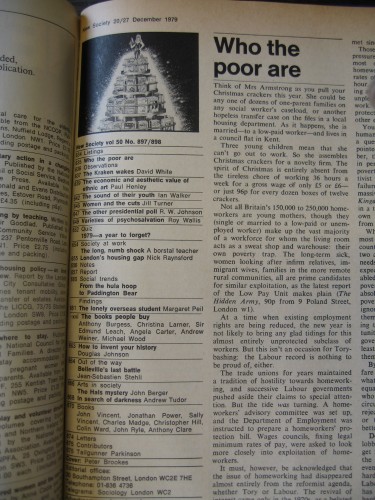
New Society, December 1979, contents page, detail
However the interior content was closer to my expectations. The inside front cover includes listings for meetings such as the “Defend the 1970 Disablement Act” to be held at a Friends Meeting House, on Euston Road, London, NW1, and announcements of publications including “Measles Misery” and “Batterered Women and the New Law,” and with an editorial next to the contents, “Who the Poor Are.” (I’m writing this the week of inner city disturbances in Britain, about which the Prime Minister is taking the position that the rioting and looting represent criminality without any relation to the poverty caused by governmental policies about jobs, education, housing, police violence, and racism). There is a public interest announcement in the form of a block of text for “A Call for Compassion” taken by the National Society for Mentally Handicapped Children [Royal Patron: HM Queen Elizabeth the Queen Mother] and on the last page the only ads, for a Berlitz cassette language course and a few social science books. And on pages 666-67, John Berger’s “The Hals Mystery.”
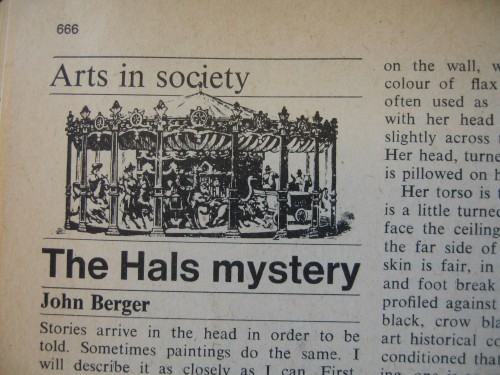
Again, as with”The Moment of Cubism,” there’s no indication of any journalistic or commercial synergy for this article, composed of evocative descriptive prose, whose basic theme is that a painter can only paint such imagery as is conceivable in his own time. Describing the bed in a painting of a nude by Frans Hals, Berger writes:
It is perhaps the sheet which most immediately proposes that the painter was Hals. Nobody but he could have painted linen with such violence and panache–as though the innocence suggested by perfectly ironed white linen was intolerable to his view of experience. Every cuff he painted in his paintings informs on the habitual movements of the wrist it hides. And here nothing is hidden. The gathered, crumpled, slewed sheet, its folds like grey twigs woven together to make a nest, and its highlights like falling water, is unambiguously eloquent about what has happened on the bed.
What is more nuanced is the relation between the sheet, the bed, and the figure now lying so still upon it. There is a pathos in this relationship which has nothing to do with the egotism of the painter. (Indeed perhaps he never touched her and the eloquence of the sheet is that of a sexagenarian’s memory). The tonal relationship between the two is subtle, in places her body is scarcely darker than the sheet. I was reminded a little of Manet’s Olympia–Manet who so much admired Hals. But there, at this purely optical level, the resemblance ends, for whereas ‘Olympia,’ so evidently a woman of leisure and pleasure, reclines on her bed attended by a black servant, one is persuaded that the woman now lying on the bed painted by Hals will later remake it and wash and iron the sheets. And the pathos lies precisely in the repetition of this cycle: woman as agent of total abandon, woman in her role as cleaner, tidier, folder. If her face mocks, it mocks, among other things, the surprise men feels at this contrast–men who vainly pride themselves on their homogeneity.
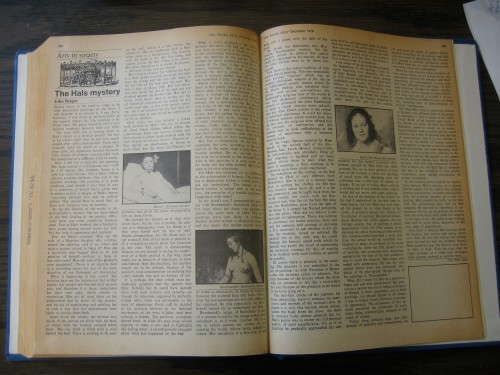
*
After Susan Bee and I had published our first few issues of M/E/A/N/I/N/G in the late 1980s, we tried to invite John Berger to write something for us. It was a quixotic gesture, in the form of a letter sent care of his publisher of the time, Pantheon Books. Needless to say, we never heard back. My view was that, as we well know, the Gods don’t answer.
But, hagiography aside, his writing provides a model for art writing that stays close to the art work itself, that is personal yet based on erudition, that is political without being in any way strident. If it veers towards the novelistic or literary, and Berger is a noted novelist and screen-writer as well as an art writer, it never falls prey to the vain side of belles-lettrism.
Reading his work for the first time in the 1980s, at a time when art writing took a sharp turn towards technical languages emerging from disciplines such as anthropology, sociology, philosophy, and psychoanalysis, I found that all of those disciplines were folded into Berger’s texts, but without a trace of the kind of specialized and often difficult terminologies and theorems that characterized the important art writing of the 1980s. It is quite interesting to me that the art writers who emerged in the late 60s and 70s, such as Berger but also, similarly, Lucy Lippard, Carol Duncan, and Linda Nochlin, wrote with a direct sensibility based in a close experience of the artwork, and from a Marxist and feminist politics, but without the layer of recondite theoretical language, or dense jargon as it sometimes seemed, that came to characterize art theory in the 1980s–and that Berger, Lippard et al were writing in this accessible manner at the same time as authors like Jacques Derrida were laying the groundwork for the more difficult and exclusionary art writing approaches of the 1980s.
So why “The Berger Mystery“?
I have to now confess how much I didn’t know about Berger when I read these two essays. What I read of John Berger including the essays in The Sense of Sight hit me like a truck, but I read only what I read and no more, and that remains true today.
I knew he had left London to live on a farm in Quincy, Mieussy, in the Haute Savoie, Rhone-Alpes region of France. This gesture alone seemed mythic, in part because I would find it very hard to leave New York City in such a definitive manner even though I do so much of my work away from the city, and in part because I spent one day and night in the Haute Savoie when I was a teenager. Away from my mother for a rare few days, in the company of distant family friends driving me through the French Préalpes for a stay in the South of France, the place we stayed the night was incredibly romantic and yet I was alone. I wept and wept at the same time as I was aware of how ridiculous my homesickness was considering the unforgettably beautiful view of steep mountains covered in thick soft green grass and cows that I saw as I looked out from the large French window of our inn.
When I read these Berger texts, I had never heard Berger speak nor seen many pictures of him. I never saw the BBC program, Ways of Seeing and I didn’t even read the book until fairly late in my feminist education. This seems incredible to me, but, despite the fact that I was closely involved with feminist art and art history as a student and young artist in the 1970s, and that, then as now, I watched a lot of television and at a time when there were still basically just three TV networks + PBS, so if you watched TV and were interested in art and in feminism (and did I mention that, to boot, I was a total Anglophile), it would be hard to miss a series like Ways of Seeing, I missed the program (though I actually do not know if it was in fact ever broadcast in the United States).
This spring I came across a lovely and very informative article about Berger, including an interview with him, published by the Guardian. The veil of mystery lifted slightly. Then last week it occurred to me that I could probably find Ways of Seeing on YouTube, like everything else, and sure enough, there he was and I must say that when reading these essays I had no idea that Berger in 1972 was a studly guy in a tight Carnaby Street style print shirt with an aristocratic lisp startlingly like Sister Wendy‘s, “we wealize,” “the pwice” [for the price], “Euwopean” (though without Sister Wendy’s overbite).
That I had so little idea of what he looked or sounded like I think was a benefit to my reading, I was the least burdened by specifics of the man as a man and could take in his ideas and his words in an act of what felt like private discovery, mind to mind. In a recent long online interview with Berger, now an incredibly healthy in mind and body seeming elderly man with pink cheeks and clear blue eyes, he says he was not good with words. But I’m happy that for a long time I had only the words. I could work from those words, without regard for the man.
(Links to a series of podcasts from 2002, of John Berger readings, and of Berger in conversation with Michael Silverblatt and with Michael Govan at Berger’s home in France, are available on the website of the Lannan Foundation. Berger’s latest book, Bento’s Sketchbook from Verso Books will be available this fall)

